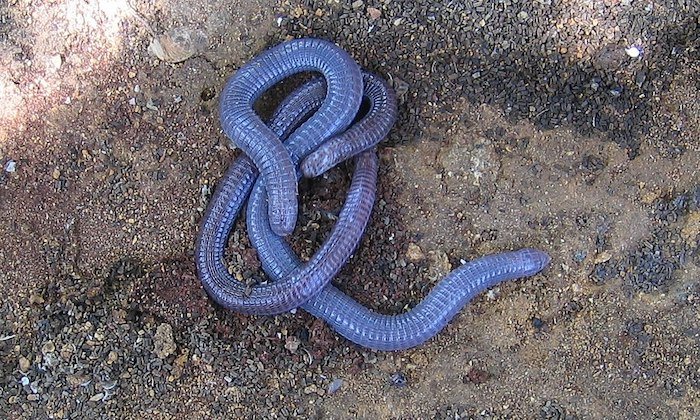Opening a Can of Worms
Bernard DUPONT from FRANCE, CC BY-SA 2.0, via Wikimedia Commons
Amphisbaenidae
by Inspector Barry Mins on April 25, 2023Hey kids, welcome back to our series on the mysteries of created kinds. Last time, we met an active, insectivorous bird kind. This week, we move from the skies to the ground—or under the ground, to be precise. This reptilian kind lives in burrows underground, rarely seeing the light of day.

Members of this kind are carnivorous, feeding primarily on insects but supplementing their diet with bits of plants.1 This presents a slight problem as they are either blind or close to blind and they live underground. To get around these problems, this kind uses special structures called chemoreceptors in the roofs of their mouths to taste the air. Their tongue flicks out, much like a snake’s, and they bring in particles from the environment, which they then taste to determine what is nearby.2 This allows them to hunt in the underground darkness without the benefit of keen vision.
Like other reptiles, they regulate their body temperature based on the temperature around them.3 Their body temperature usually is within approximately one degree Celsius of the surrounding dirt or sand.4 In some species, males and females will inhabit the same environment.5 Males and females in at least some species are sexually dimorphic, but the differences are minor, confined to weight and head and tail size.6 Little is known about reproduction in this kind, but eggs are laid in small clutches, and the offspring hatch about a month after being laid.7
Has anyone figured it out yet? This week’s kind is the Amphisbaenidae—the worm lizard kind. These normally legless lizards are quite at home in the tropical and desert regions of the world, but unless you live in Florida, you won’t find any in your yard if you live in the US. Stay tuned for next week when we go looking for a very colorful group of tropical birds.

Two Iberian worm lizards. Richard Avery, CC BY-SA 3.0, via Wikimedia Commons
Try out this fun word search!
Clue
Your clue for the week is:
These birds have large colorful bills and come in a myriad of colors and patterns.
Ask a Question
Have you ever had a question about created kinds but didn’t know who to ask? Have you ever wanted to learn more about your favorite kind? Well, now you can! You can ask me, Inspector Barry Mins, a question! Have your parents help you fill out this form, and you might get your question answered in my column! If you have any questions about created kinds, feel free to send them my way!
Footnotes
- B. A. Paray, M. K. Al-Sadoon, and H. A. Rudayni, “Diet of the Worm Lizard Diplometopon zarudnyi (Nikolsky, 1907) in the Riyadh province, Saudi Arabia (Reptilia: Trogonophidae),” Zoology in the Middle East 62, no. 3 (2016): 227–230.
- P. López, J. Ortega, and J. Martín, “Chemosensory Prey Detection by the Amphisbaenian Trogonophis wiegmanni,” Journal of Herpetology 48, no. 4 (2014): 514–517.
- P. López, E. Civantos, and J. Martín, “Body temperature regulation in the amphisbaenian Trogonophis wiegmanni,” Canadian Journal of Zoology 80 (2002): 42–47.
- J. Martín, P. López, and A. Salvador, “Field body temperatures of the amphisbaenid lizard Blanus cinereus,” Amphibia-Reptilia 11 (1990): 87–96.
- J. Martín, N. Polo-Cavia, A. Gonzalo, P. López, and E. Civantos, “Social aggregation behavior in the North African amphisbaenian Trogonophis wiegmanni,” African Journal of Herpetology 60, no. 2 (2011): 171–176.
- J. Martín, N. Polo-Cavia, A. Gonzalo, P. López, and E. Civantos, “Sexual Dimorphism in the North African Amphisbaenian Trogonophis wiegmanni,” Journal of Herpetology 46, no. 3 (2012): 338–341.
- M. K. Al-Sadoon, S. A. Kandeal, and H. A. Rodiny, “Reproductive characteristics of the worm lizard, Diplometopon zarudnyi, in relation to months of the year in Riyadh region of Saudi Arabia,” Comptes Rendus Biologies 337, no. 4 (2014): 229–234.
- © 2024 Answers in Genesis
- Privacy Policy
- Contact
- About
